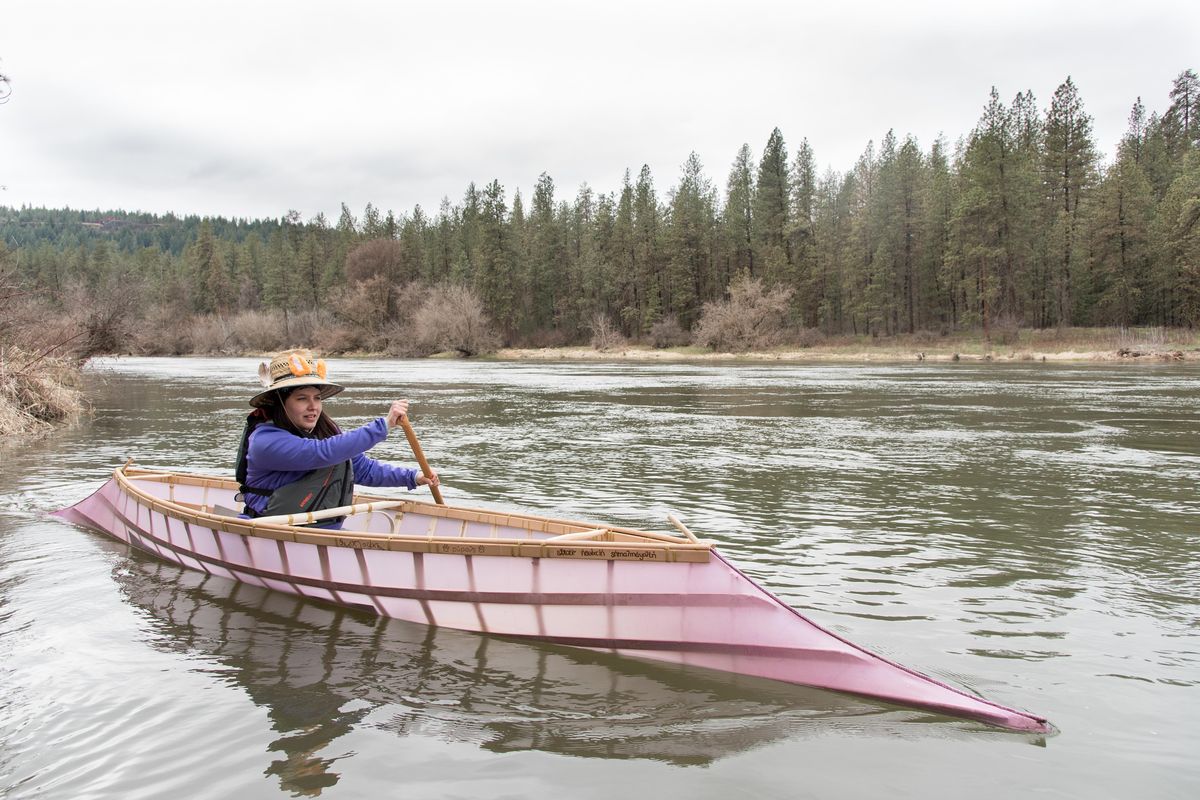Spring break canoe project connects, heals Salish School of Spokane participants

It’s not a particularly glamorous affair. The day is overcast. The river bursting with rain.
In fact, seen from a certain perspective, it’s mundane. A canoe, drifting down the river. Crystal Conant steered the craft, fighting a bit to keep the vessel moving in the direction of her will. No different than a thousand other trips taken down the Spokane River.
But zoom out any amount, even 10 feet, and the scene changes. On the bank, 12 others watch and cheer Conant along. Most of whom are Native Americans. They ranged in age from young to old.
Step back again, this time historically. Imagine this area, Plese Flats on the Spokane River, as it was 150 or 250 years ago.
No cars in the lot. No mountain bikes navigating the trees. A faster, more vigorous river.
It’s all different, seen from that perspective.
Except the canoe.
Because the purple canoe, painted in honor of huckleberries, was built using traditional Native American techniques.
Over the course of a week, students at the Salish School of Spokane built the canoe using knowledge passed from from generation to generation of Native Americans.
The canoe-making process was nearly lost with the destruction and dispersion of Native American families and culture.
But some few have dedicated themselves to reviving that knowledge. For those who experience it, the revival feels nothing short of miraculous.
“That was amazing,” said Conant, the woman who steered the craft on its maiden voyage. “It brings back our history and our ancestors.”
Shawn Brigman has dedicated himself to learning and teaching these skills. He helped the Salish School students, staff and parents build the canoe. Although some of the materials are modern – such as the skin of canoe which is made of ballistic nylon instead of western white pine bark – the design and overall process remains more or less untouched.
The canoe, called a Salishan Sturgeon Nose Canoe, is 16 feet long and weighs between 35 and 40 pounds.
Brigman learned to make the traditional canoes about six years ago. Now Brigman, who is a Spokane tribal member, runs his own company called Interior Plateau Recovery Arts. The sturgeon nose canoe was traditionally built by northern plateau bands, including the Spokane Tribe.
The canoe was built during the Salish School’s spring break. The Burke Museum donated $6,000 to the project, which covered the material costs and Brigman’s time.
Traditional canoe building has had a resurgence in the Spokane area. Last year, members of the Kalispel Tribe paddled 51 miles on the Pend Oreille River in traditional-style dugout canoes from Sandpoint to the tribe’s powwow grounds in Cusick, Washington. Members of the Spokane and Coeur d’Alene tribes also participated.
The three canoes were among the boats created in 2016 from six old-growth cedar logs sold to the Upper Columbia United Tribes by the Quinault Indian Nation in Western Washington. The Upper Columbia United Tribes – the Kootenai, Colville, Coeur d’Alene, Kalispel and Spokane – all received cedar logs estimated to be between 500 to 900 years old.
Annette Matt helped build those dugout canoes, participated in the paddle and was involved in building the Salishan Sturgeon Nose Canoe last week.
Standing under a covered patio last week while the canoe was being built, Matt had a visceral reaction while recounting her first time in a dugout canoe.
“Oh, it’s so healing,” she said. “When you get into the canoe and realize …”
She paused. “It’s giving me the chills right now. This is what our ancestors did. It’s complete connection.”
Reviving and animating those traditions is central to the Salish School’s mission.
The Salish School of Spokane, which opened in 2010, is the only full-time, off-reservation Native American language immersion school in the continental U.S.
The all-day school teaches all subjects in Salish, an indigenous language.
After the maiden voyage at Plese Flats, the canoe will return to the Salish School of Spokane, where it will serve as a visible reminder of the kind of recovery and healing work the schools aims to do. Work that, as evidenced by the canoe’s melding of old techniques and new materials, embraces the modern while simultaneously honoring the ancient.